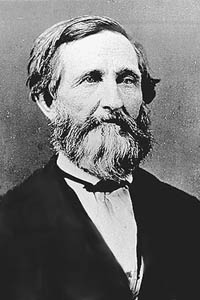 SKC Films Library SKC Films Library |
|
|
| SKC Films Library >> Medicine >> Surgery |
 Crawford
Long Crawford
Longthe first to use sulfuric ether as an anesthetic Crawford Williamson Long was born in Danielsville, Georgia, on November 1, 1815, the only son of a wealthy merchant and planter (he did have two sisters, however). His father's wealth allowed Crawford to receive an excellent education, but by the time he was fourteen he had exhausted all of the learning potential available to him locally so he entered Franklin College (now the University of Georgia, Athens). He received his A.N. degree from that institution in 1835, and then entered medical training at Transylvania College in Lexington, Kentucky. After a year at Transylvania, he transferred to the University of Pennsylvania, from which he received his medical degree in 1839. After a two-year hospital internship in New York City, he took over a rural medical practice in Jefferson, Georgia. In 1842, he married Caroline Swain, who subsequently bore him twelve children, seven of whom survived to adulthood. While in New York City, Long took part in the "laughing gas parties" that were then all the rage among the social elite. And, like some other participants, he noticed that people under the influence of "laughing gas" could suffer injuries (cuts, bruises, etc.) without feeling any pain. Having first-hand experience with surgeries conducted on patients who were very painfully aware of everything being done to them, Morton wondered "laughing gas" or something similar could be used as an anesthetic. Unable to obtain "laughing gas," he decided to experiment with sulfuric ether. On March 30, 1842, he administered sulfuric ether to James Venable, and then proceded to remove a tumor from his patient's neck. After Mr. Venable emerged from his ether-induced slumber, Dr. Long showed him the tumor he had removed, and Mr. Venable reported that he had felt nothing during the procedure. After this success, Long continued his experiments and gradually introduced the use of ether into his surgical practice. Although his work was never deliberately kept a secret, Long chose not publish his findings right away because he wanted to be absolutely sure of his discovery. On September 30, 1846, Boston dentist William T.G. Morton publicly demonstrated the use of ether during a tooth extraction. The demonstration had been conducted at the suggestion of Boston chemist Charles T. Jackson, and the two men were awarded a patent for their use of ether as an anesthetic later that same year. It wasn't until Long began reading about Morton's work and patent that he decided to start collecting his notes, along with notarized statements from many of the patients he had used ether on. The collection was published in the December 1849 issue of Southern Medical and Surgical Journal. Long did not publish his work in an effort to seek wealth or fame, however, he simply wanted recognition for having been the first to successfully use ether as an anesthetic. That recognition would not come in his lifetime, however. In 1851, Long moved his family to Athens, Georgia, where he and his brother Robert opened a pharmacy and medical practice. During the Civil War, he served as a surgeon to soldiers on both sides. He practiced medicine until the last day of his life, which came on June 18, 1879, soon after he attended a childbirth (during which the mother was anesthesized with ether). On June 18, 1879, the National Eclectic Medical Association passed a resolution declaring Long as the discoverer of ether as an anesthetic, and the majority of the medical community acknowledged that declaration soon after. A marble bust of him represents Georgia in the U.S. Capitol's Statuary Hall. SEE ALSO |
| SKC Films Library >> Medicine >> Surgery This page was last updated on 04/18/2017. |